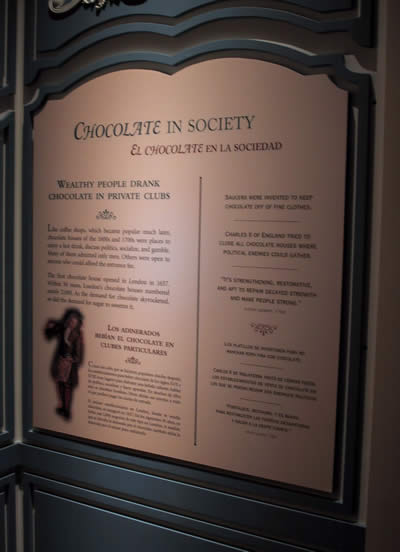|
|
|
|
|
|
|
|
Although
Dianne, Megan and I all enjoy chocolate to varying degrees,
I'm no expert on the stuff. In my mind, Milton Hershey invented
the chocolate bar around 1900 and it all sort of grew from
there. Not so!
|
|
|
|
Dianne
stands in front of a photo realistic flat of a chocolate store
|
| |
Chocolate
has a long and somewhat fascinating history. As the displays
point out, chocolate seems to have had its beginnings with
the cacao tree in the South American rainforest. That's
Cacao [spelled correctly and pronounced 'kuh-kow].
The
exhibit moves quickly and chronologically, walking visitors
through chocolate highlights in large broad strokes. Which
works just fine.
|
|
|
-
900 BC -
Ancient
Maya made cacao into a spicy beverage for ceremonies and
trade. The intricately carved flagon is one of many on display.
This
begins a trend toward what would become chocolate.
|
-
13th Century - Aztecs treated cacao as a luxury
item, using cacao seeds as a form of money.
-
16th Century -- Chocolate
reaches Europe. Spaniards add sugar to it, making it more
drinkable.
|
|
|
|
|
|
-
1700 -
More than
2000 chocolate houses in London alone. Sort of the Starbucks of
its time.
|
|
|
|
Names
now familiar in the chocolate business pop up, providing
some 'a-ha' moments.
-
1868 -- Richard Cadbury introduces the first
box of chocolates.
-
1870
-- Henri Nestle develops the first milk chocolate bar
-
1893 -- Milton Hershey builds a manufacturing
plant in rural Pennsylvania.
|
|
|
And
then flash forward into more modern times where Manufacturer,
Scientist, Trader, and Store Manager [left] all play
a role in getting chocolate to the market place.
Additional
information about cacao and chocolate is provided in the
form of intereactive kiosks provide multiple-choice questions
and push the button to get the answer.
|
The
final display is a series of television monitors dressed
up as a large box of chocolates.
To view
the short presentation, visitors sit on giant-sized chocolates
- actually soft pillowy seats complete with those neat dark
brown doilies.
|
|
|
|
|
|
|
|
|
|
|
|
|
|
|
|
|
|
|
|
|
The
exhibit is short and dare I say, sweet, ending in a cute
little shop featuring books, T-shirts, postcards, candy
and all things chocolate. [left]
Much
of it is custom-designed just for the chocolate exhibit.
[below]
|
|
|
|
|
|
|
|
|
|
|
|
|
|
Overall,
this a cute little exhibit. It tends to be just a bit academic
and serious -- this is chocolate for gosh sakes! We were
so wishing that an actual person mixing and making actual
chocolate would have been present giving away actual samples.
Imagine the smells and tastes. Yum.
Is the
'Chocolate' exhibit worth the $8.00 adults and $2.00 children
admission? Probably not by itself. However, keep in mind
that a ticket allows access to the entire museum grounds
- with everything from dinosaurs, mammals, and birds to
minerals, gems and Native American Culture. If you haven't
been to the Natural History Museum, it really is a great
place to take a day and explore.
|
|
|
|
| |
| |
As
a reminder, The California Science Center is within walking
distance and has free admission to the permanent exhibition
galleries. Their new exhibit, Titanic: The Artifact Exhibit,
opened on February 9th, and does require tickets. Adults
$9.50 and Children $4.50. Titanic:
The Artifact Exhibit Tickets
|
|
|
| |
One
final word about chocolate. We haven't become chocolate
snobs. Along with those little 1 oz. bars, we also taste-tested
a Caramel Nut Buddy from Helen Grace Chocolates - a sponsor
for the LA leg of the 'Chocolate' tour. This candy bar,
at $1.69 for 1.75 oz., is a wonderful combination of peanuts
and caramel coated in a great tasting chocolate.
As far
as I'm concerned, it beats Mexico Milk, Ecuador Milk and
Dark Ivory Coast hands down.
Chocolate:
The Exhibition - February 16 - May 11, 2003
For more information click the logo below
|
|
|
|
|
| |
| |
|
|
| |
|
| |
|
|
|
|
|
|
|
|
| |
|
|
|
|
|
|
|
